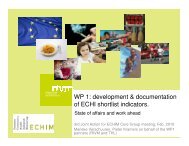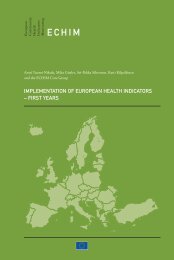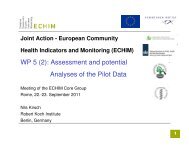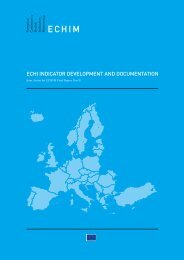INDICATORS
ECHIM Final Report
ECHIM Final Report
You also want an ePaper? Increase the reach of your titles
YUMPU automatically turns print PDFs into web optimized ePapers that Google loves.
17. EXCESS MORTALITY BY HEATWAVES<br />
Definition: Measurement of the effect of elevated temperatures on mortality in a region /<br />
Member State / European Union.<br />
Calculation: Indicator needs more development. Its calculation is based on day-by-day<br />
regional mortality and temperature analysis in the (common) summer period: Daily number<br />
of observed deaths in a region during a heatwave in relation to expected number of deaths in<br />
that time, expressed as number of a) excess deaths and b) excess death rates due to heatwaves.<br />
Expected number of deaths at a certain day is estimated from past number of deaths or past<br />
daily death frequencies or both.<br />
The oldest age group is often limited to age 85+, and thus data are presented as: all, below<br />
65, 65-84 and 85+.<br />
Notes: Heat-related deaths are not well defined and heat is usually not listed on death<br />
certificates as causing or contributing to death. Heat is recorded from other sources.<br />
In principle, the daily excess mortality in summer (well as in winter) can be computed almost<br />
live, i.e as soon as the number of deaths of the day in question is known. It is much more<br />
complex and need more time to calculate excess death rates, as one needs estimates of the size<br />
of exposed population in the year in question. Therefore the death rates of summer Y cannot<br />
be computed before you get the population estimates by January fist of the year Y + 1.<br />
18. SELECTED COMMUNICABLE DISEASES<br />
Definition: The indicator for selected communicable diseases consists of two indicators:<br />
1) “Incidence of selected communicable diseases”, which comprises of the diseases of<br />
the highest incidence and/or disease burden, minimally Chlamydia, Hepatitis C and<br />
Tuberculosis.<br />
2) “Incidence of vaccine-preventable diseases”, which comprises of a set of vaccinepreventable<br />
diseases with variable coverage of vaccination, minimally Pertussis, Measles and<br />
Hepatitis B.<br />
Calculation: The incidence of a disease per year is calculated as the total number of reported<br />
new cases of the disease in a specific year divided by the population of the country in<br />
question in the same year, expressed per 100 000 population.<br />
Notes: The data will be available through the surveillance systems covered by The European<br />
Centre for Disease Prevention and Control, ECDC.<br />
19. HIV/AIDS<br />
Definition: Incidence of a) HIV-infected and b) AIDS cases, in a calendar year. A case of<br />
HIV infection and AIDS are defined following the European AIDS and HIV surveillance<br />
case definitions.<br />
Calculation: The rates are calculated as the number of newly diagnosed cases (of HIVand<br />
AIDS) per million inhabitants, based on the number of reported cases reported by national<br />
surveillance systems (as reported to the European Centre for the Epidemiological Monitoring<br />
of HIV and AIDS). Rates are calculated in year x for the year x-1 to account for delayed<br />
reporting.<br />
94










